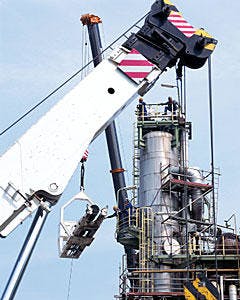Strategies and practices to achieve planned major maintenance and inspection shutdowns vary considerably throughout the oil and gas industry. This is interesting because all operators face the same challenges: to restore technical capabilities fully, minimize downtime, and satisfy government inspectors for the next run period.
And, of course, the health, safety, and environmental (HSE) records must remain impeccable, while the economics of the entire venture stay attractive. So, what options do we have to achieve best in class?
Clearly, approaches will be influenced by where in the world we operate. Running a refinery in most of the US or Western Europe provides easy (i.e., economic) access to contractor resources, heavy equipment, and other necessities. Operators in such remote areas as Nigeria or Algeria face additional challenges.
Simply put, it boils down to the ability to optimize the scope of work for the shutdown, estimate and plan the required resources, bring them together just in time, then work the plan as forecast.
The success of such an operation greatly depends on the availability of the following:
- Extensive expertise.
- Detailed information about equipment condition.
- Risk profile of the equipment.
- Professional planning capabilities.
- Flexible resource pool.
- Effective organization.
The question is how to achieve each of these requirements and, more importantly, how to make them work together to produce best-in-class performance. When looking at the merits of different strategies, it is important to consider the size and complexity of the facility. This article is concerned with larger units
The ultimate best-practice approach has evolved over the last 25 years, driven by the development of contractors specialized in providing services to the oil and gas industries. Former oil industry workers with extensive experience in the business staff many of these contractor companies.
With such technical services available on the market, many oil and gas operators seized the opportunity to focus on their core business and leave the supporting services to highly skilled contractors.
Strategies
Below is a brief description of three strategies. For each, there may be many variations. Behind these three main strategies, however, lies the idea of showing how, through time and experience, best-in-class operators have moved to the most effective shutdown practice.
- Execution of the shutdown by a contractor only (Table 1) is a tendered activity, in which the operator invites tenders from a number of contractors with known good track records in the shutdown business. The contractors must plan the actual shutdown, provide resources, and carry it out. The engineering department of the operator carries out plant modifications and upgrades. The operator orders and stores materials.
An issue may be the position of original equipment manufacturers with whom most operators have a contract for the maintenance of their major equipment.
This rather old fashioned strategy holds little incentive for the contractor to minimize cost. Sensitive issues are the management of extra work and on-time delivery of parts and materials by the operator.
Another difficulty is the coordination between plant modification work and shutdown work executed in the same area. The major problem is the alignment of the operator’s objectives with the objectives of the contractors working during the shutdown. If one of the contractors is optimizing his company’s objective of profit, he could jeopardize the overall success of the shutdown. An attempt to avoid this could be the tendering based on lump sum prices by the operator.
This usually leads to higher prices by the contractor in an attempt to cover perceived risks. This approach is still applied by many smaller operations for small shutdowns. Table 1 highlights the distribution of responsibilities for different activities. All these activities are related and need close overall coordination in order to achieve best-practice shutdowns. It is easy to see that the high number of interfaces and the distribution of responsibilities leave a lot of room for errors and inefficiencies.
- The contractor providing the shutdown service (Table 2) is also a tendered activity. In this case, the contractor is bidding for a more complete service. It is an extension of the first strategy but now covers all planning activities, parts and materials ordering, and storage management. Also included are the analysis of maintenance and inspection data and collection of all relevant documents and drawings.
The operator is less involved but still maintains a skeleton shutdown organization. Also, there is no real alignment of objectives. The more expensive the shutdown, the more the contractor benefits.
Lessons learned from these classical tendered shutdown approaches are:
- There is no real commercial incentive for the contractor to achieve the operator’s objectives.
- No contract can avoid disputes about extra work, quality of work, meeting target dates, and other issues.
- Operator’s involvement remains high in order to ensure value for money.
- The contractor’s commercial planning horizon remains short, moving from one shutdown to another between different operators.
- All this can be improved by a long-term alliance with a carefully selected contractor (Table 3). It may take up to 2 years to reach that stage after the decision to seek an alliance. Time must be taken to review a number of potential partners.
Beyond the obvious quality and capability issues with which the contractor must comply is the matter of company culture. The contractor is typically a broad based, internationally operating contractor with direct access to all technical skills required by the operator. For the venture to succeed, there must be a match in values, missions, and visions. That may not be as easy as it looks.
The duration of the shutdown is a function of the shutdown operations and the personnel employed. A qualified contractor for planning and realization must be in a position to judge the work to be done and to decide whether the operation can be carried out during normal maintenance and servicing.
Statistical data are based on the assumption that, due to the planning and coordination to be made, shutdown operations are two to three times more expensive than the maintenance carried out during the daily work. If the extent of work for the shutdown is optimized, the contractor can plan the maximum number of workers and thus define the shutdown period.
For a refinery with a capacity of 200,000 b/d, the costs for each additional day of shutdown amount to about $250,000. These costs consist of lost revenue, labor (in-house and contractors), equipment, extra charges, and energy expenses. Purely arithmetically, it would be cheaper to increase the staff by 250 joint laborers for 24 hr than to extend the shutdown by 1 day.
The costs for the shutdown and for exceeding the planning, if necessary, are a matter of conflict between the plant operator’s interests to save costs on the one hand and those of the contractor to make a profit on the other.
Ferrostaal IPS GMBH’s experiences with a risk and reward system indicate that it offers an advantage to both parties concerned. The contractor reveals his costs to the customer. The shutdown will be realized at costs plus a low profit.
The profit-loss resulting from an overrun or underrun of the following factors will be divided between customer and contractor with the loss of $250,000/day for the refinery, mentioned previously, being the criterion:
- Duration of the whole shutdown.
- Optimization of the employment of equipment.
- Optimization of the subcontractors’ employment.
The shutdown must be accident free and achieve high quality. If the general contractor includes his subcontractors in this risk-reward system, all parties concerned will aim at an optimum realization of the shutdown. This applies in particular if the general contractor realizes several shutdowns at the same time and can thus use his critical resources flexibly.
The best of two worlds can be achieved: An effective operator and a broad-based technical company that carries out all the technical work, both being experts in their core businesses but with a single objective. Carefully worked out incentive schemes will help align objectives.
Now, the contractor has a long-term agreement:
- All maintenance work: routine, breakdown, and shutdown.
- Plant modifications.
- Engineering work.
- Construction work.
This integration of technical activities over a long period provides the basis for the technical contractor to achieve the best possible in technical, economic, and HSE performance.
It should be remembered, however, that once the alliance starts to function, it needs time to develop into a firm partnership. It takes time and experience to develop the mutual trust required to make it work. Also, incentive schemes are never perfect from the outset. They need refinement as experience is gained. The key word is trust; the rewards are high.
The authors
Sonny Volkerts ([email protected]) is a retired production engineer of Shell International Petroleum Maatschappij. He has more than 30 years’ experience in both up and downstream oil and gas operations. During this period, he worked for Shell in Cura
Oliver Laubner ([email protected]) is a sales manager for project development of the international business of Ferrostaal Industrial Plant Services GMBH. During the last 4 years, he was responsible for the establishment of outsourcing projects in Southeast Asia and Middle East. He has more than 8 years’ working experience in the up and downstream industries with Dresser Inc. MAN AG, and Ferrostaal IPS. Laubner holds an engineering degree from the University of Braunschweig, Germany, and an MBA from NIMBAS, The Netherlands, and Bradford, UK.)








